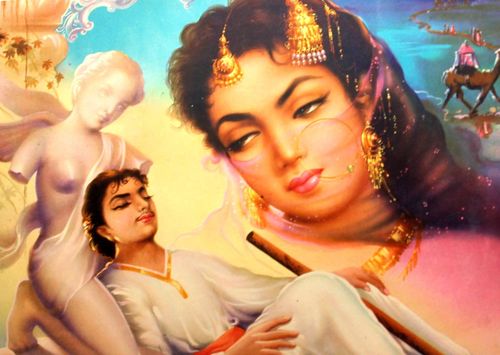FWP:
SETS == A,B; GENERATORS; MIDPOINTS
Farhad was nicknamed 'Kohkan' (literally, 'Mountain-digger'), and he dug through impossible wildernessess of stone to carve out a channel that would carry milk for Shirin's bath (see {1,2}). Was there also a story of his having made a stone statue of her? If so, I've never heard of it, and it doesn't seem that the commentatore have either; we are thus on fresh ground when it comes to interpreting the verse.
In this strikingly (sorry, sorry) 'A,B' verse, what exactly did Kohkan do? Beyond the fact that he created a single [yak] image of Shirin, we can't be at all sure. For the second line comes to us wrapped in several layers of ambiguity.
First, the adverbial phrase sang se can be read with either sar maar kar ('having struck the head with a stone') (2a), or else hove nah paidaa ('would not be created/born from stone') (2b).
Second, although the line has the form of a negative statement ('it would not be'), the more tentative nah hove rather than the decisive nahii;N hotaa or the like, seems to invite us to place a (colloquially omitted) kyaa in front of the line, and turn it also into a question ('would it not be?'). Such an insertion is eminently possible and legitimate; in one notable case, {36,10}, it's actually even required for intelligibility. In the present verse it's not required, but it feels very natural and legitimate. It's certainly a very defensible alternative reading.
Third, we have to decide about the relationship between the two lines. Most fundamentally, we have to decide whether Kohkan's acting as a 'carver/sculptor' in the first line is separate from his 'striking his head' in the second line, or whether both lines describe the same action; the verse gives us no guidance whatsoever. We also have to decide whether the 'image' of Shirin is in any way desirable or satisfactory (to Kohkan if to no one else), or whether it's merely a useless chunk of stone and a source of frustration. (Here yak is apparently not as protean as ek would have been.)
The commentators generally assume that by striking his head with a stone, Kohkan in his madness created an image of Shirin-- but it was only an image. An image in his spinning head, presumably. Could any other true lover have done better, though? The commentators assume so, but I don't see why. The second line is on one reading very flatly negative about any such possibility: striking one's head with a stone would not give rise to intimacy. In his passion and torment he did the best he could, but he could not go as far as he would have wished, and actually reach out to the living Shirin. But of course, the line could also be read as an interrogative, if we imagine a kyaa in front of it-- as we are well entitled to do. On that reading, perhaps Kohkan even succeeded in creating at least something or someone. And who is to say that it wasn't better than nothing?
On the other hand, there's a whole set of 'snide remarks about famous lovers', and this verse may well be one of them; for a list, see {100,4}.
Choosing a single meaning for a verse like this forces us into the position of the blind man and the elephant. The brilliance of Ghalib is to compress into a tiny two-line verse the whole elephant, and to keep our minds constantly roving over it.
There are also the sound effects of sang se sar
maar kar . All those consonants and short, clipped syllables have a choppy
effect-- like thrown stones.

Nazm:
That is, he was only a sculptor, not a true lover. Otherwise it would have been surprising-- that he would strike his head with a stone, and the beloved would not emerge from it? (40)
== Nazm page 40